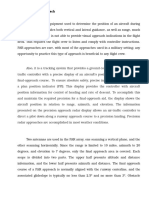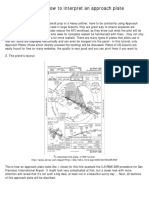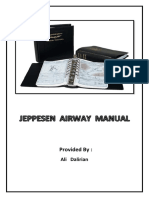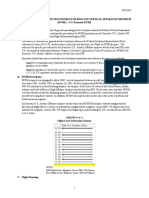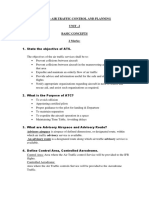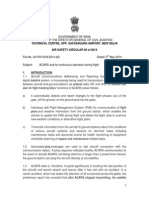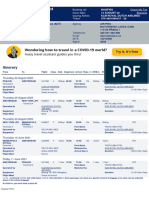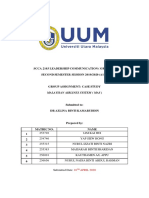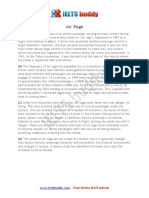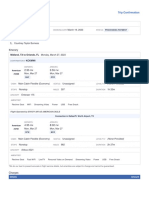NDA Supplement
NDA Supplement
Uploaded by
gilbertownovaesOriginal Description:
Copyright
Available Formats
Share this document
Did you find this document useful?
Is this content inappropriate?
Report this DocumentCopyright:
Available Formats
NDA Supplement
NDA Supplement
Uploaded by
gilbertownovaesCopyright:
Available Formats
Calm Air International LP
Annual Recurrent Training
Flight Crew
INTRODUCTION
This supplement has been prepared as the basis for Annual Recurrent Training Program for Flight Crew, which
includes a number of general topics. This training course is delivered via ‘distance’ and is hosted online on the
Compass internal website, and is to be completed through self-study.
Please review the 2014 Supplement. There is a comprehensive multiple choice exam to be completed online; the
exam pass mark is 80%. The exam is open book, and is based entirely of the material in this document, or other
company manuals that are referenced (i.e., Calm Air Operations Manual) which you already have access to.
OPERATIONS IN NORTHERN DOMESTIC AIRSPACE
Northern Domestic Airspace
Canadian Domestic Airspace is geographically divided into the Southern Domestic Airspace and the Northern
Domestic Airspace as shown in the figure below. In the Southern Domestic Airspace, magnetic track is used to
determine cruising altitude for direction of flight.
The Magnetic North Pole is located near the centre of the Northern Domestic Airspace, therefore magnetic
compass indications may be erratic. In this airspace, runway heading is given in true and true track is used to
determine cruising altitude for direction of flight in lieu of magnetic track.
October 2016 Page 1
Calm Air International LP
Annual Recurrent Training
Flight Crew
Controlled airspace within the High
Level Airspace is divided into three
separate areas. They are the
Southern Control Area (SCA), the
Northern Control Area (NCA) and the
Arctic Control Area (ACA). Their
lateral and vertical dimensions are
illustrated in Figure below. Vertically,
they are: SCA, 18 000 feet ASL and
above; NCA, FL230 and above;
ACA, FL270 and above. The volume
and concentration of international air
traffic transiting the NCA and ACA on
random tracks can create enroute
penalties to users by preventing
maximum utilization of the airspace.
To ensure the flow of traffic is
accommodated efficiently, a track
system has been established which
interacts with the established airway
system in the SCA and Alaska. Use
of these tracks is mandatory at
certain periods of the year.
Arctic Radio
Arctic Radio operates from the North Bay FIC (Ontario). It provides FISE and emergency communication to
aircraft operating in the Northwest Territories and Nunavut and in the vicinity of the ADIZ. It also provides radar
position information (latitude and longitude, bearing and distance, altitude and ground speed) upon pilot request.
Page 2 October 2016
Calm Air International LP
Annual Recurrent Training
Flight Crew
Air Defence Identification Zone
The air defense identification zone (ADIZ) is an area of airspace within which "the ready identification, the
location, and the control of aircraft are required in the interest of national security". Typically, an aircraft entering
an ADIZ is required to radio its planned course, destination, and any additional details about its trip through the
ADIZ to a higher authority, typically an air traffic controller.
In North America, the United States and Canada are surrounded by an ADIZ, which is jointly administered by the
civilian air traffic control authorities and the militaries of both nations, under the auspices of the North American
Aerospace Defense Command (NORAD).
The joint US/Canadian ADIZ, which is almost exclusively over water, serves as a national defense boundary for
aerial incursions.
October 2016 Page 3
Calm Air International LP
Annual Recurrent Training
Flight Crew
CAR 602.145 ADIZ
(1) This Section applies in respect of aircraft before entering into and while operating within the ADIZ, the
dimensions of which are specified in the Designated Airspace Handbook.
(2) Every flight plan or flight itinerary required to be filed pursuant to this Section shall be filed with an air
traffic control unit, a flight service station or a community aerodrome radio station.
(3) The pilot-in-command of an aircraft whose point of departure within the ADIZ or last point of departure
before entering the ADIZ has facilities for the transmission of flight plan or flight itinerary information shall:
(a) before takeoff, file a defence flight plan or defence flight itinerary;
(b) in the case of a VFR aircraft where the point of departure is outside the ADIZ,
(i) indicate in the flight plan or flight itinerary the estimated time and point of ADIZ entry,
and
(ii) as soon as possible after takeoff, communicate by radio to an air traffic control unit, a
flight service station or a community aerodrome radio station a position report of the
aircraft’s location, altitude, aerodrome of departure and estimated time and point of ADIZ
entry; and
(c) in the case of a VFR aircraft where the point of departure is within the ADIZ, as soon as
possible after takeoff, communicate by radio to an air traffic control unit, a flight service station or
a community aerodrome radio station a position report of the aircraft’s location, altitude and
aerodrome of departure.
(4) The pilot-in-command of an aircraft whose point of departure within the ADIZ or last point of departure
before entering the ADIZ does not have facilities for the transmission of flight plan or flight itinerary
information shall:
(a) as soon as possible after takeoff, file by radio communication a flight plan or flight itinerary;
and
(b) in the case of a VFR aircraft, indicate in the flight plan or flight itinerary the estimated time and
point of ADIZ entry, if applicable.
(5) The pilot-in-command of a VFR aircraft shall revise the estimated time and point of ADIZ entry and
inform an air traffic control unit, a flight service station or a community aerodrome radio station, when the
aircraft is not expected to arrive:
(a) within plus or minus five minutes of the estimated time at:
(i) a reporting point,
(ii) the point of ADIZ entry, or
(iii) the point of destination within the ADIZ; or
(b) within 20 nautical miles of:
(i) the estimated point of ADIZ entry, or
(ii) the centre line of the route of flight indicated in the flight plan or flight itinerary.
Page 4 October 2016
Calm Air International LP
Annual Recurrent Training
Flight Crew
Area of compass unreliability
The Earth's North Magnetic Pole is the point on the surface of the
Northern Hemisphere at which the Earth's magnetic field points
vertically downwards.
The North Magnetic Pole moves over time due to magnetic
changes in the Earth's core. In 2001, it was determined by the
Geological Survey of Canada to lie near Ellesmere Island. In 2009,
it was moving toward Russia at 55-60 km per year. During the 20th
century it moved 1100 km, and since 1970 its rate of motion has
accelerated from 9 km/year to approximately 41 km/year.
The horizontal force of the magnetic field, responsible for the
direction in which a compass needle is oriented, decreases in
strength as one approaches the North Magnetic Pole, where it is
zero. Close to the pole, an area is reached where the frictional
forces in the pivot are comparable to the horizontal forces of the
magnetic field. The compass starts to behave erratically when the
horizontal force falls below 6000 nT, and eventually, as the
horizontal force decreases to less than 3000 nT, the compass
becomes unusable.
These definitions are only guidelines, and experience has shown that with care, high quality mechanical
compasses can be used, even in areas where the horizontal force is less than 3000 nT. Electronic compasses will
operate regardless of the horizontal field strength. However, both mechanical and electronic compasses are
subject to another problem within the area of compass unreliability - daily fluctuations in magnetic declination
become increasingly large as one approaches the North Magnetic Pole. Where the horizontal force is less than
3000 nT, daily fluctuations in excess of 5 degrees are normal. Therefore, even if you compass is functioning
correctly it may not be pointing where you think it is.
October 2016 Page 5
Calm Air International LP
Annual Recurrent Training
Flight Crew
Establishing a TRUE heading in NDA
Operations in Northern Domestic Airspace require special procedures due to magnetic compass unreliability. The
aircraft compasses shall be operated in DG mode and set to true headings at all times in Northern Domestic
Airspace.
Flight Management Systems & ADF Bearing Pointer
The FMS in combination with an ADF pointer shall be used to determine true heading while operating in Northern
Domestic Airspace. The FMS is NOT capable of determining true heading. It is capable of giving true aircraft
tracks, exact latitude and longitude position, and exact bearing information.
NOTE: The Astro Compass must be carried (as a back-up) at all times the aircraft is operated in Northern
Domestic Airspace.
ADF Bearing / True Heading setting procedure:
Tune and Identify the closest NDB to aircraft position.
Determine the True bearing of the NDB using the aircraft GPS
Turn the aircraft AHRS DG Clockwise (CW) or Counter Clockwise (CCW) until the True Bearing
determined from the FMS matches up exactly with the ADF bearing pointer.
The following procedures for operating in the NDA apply:
Select DG mode prior to departure
On line up checklist verify runway heading is set in DG (AHRS 1 & 2)
On a continuous basis during flight apply compass corrections using the FMS and an ADF bearing
pointer.
During decent checklist and prior to commencing any approach procedure, check True Heading and
confirm DG mode selected.
In the event FMS (GNSS) or an NDB (to get a bearing from) becomes unavailable the Astro Compass must be
used to determine True Heading.
Page 6 October 2016
Calm Air International LP
Annual Recurrent Training
Flight Crew
Astro Compass
Check True Heading by the SUN
1. Set latitude to the nearest degree. (YRT N62 48.64)
2. Extract declination and G.H.A. SUN from the almanac.
3. Calculate L.H.A. SUN:
L.H.A. SUN = G.H.A. – West Longitude to nearest ½ degree
Example: G.H.A. for 7 June 2012 at 1600 is: 60 15.6
CYRT Longitude is: W92 06.8
60 – 92 = 328 L.H.A. SUN
4. Set L.H.A. SUN on hour angle head (N).
5. Set declination. (N22 49.8)
6. Hold compass level in sunlight with lubber line pointing in same direction as aircraft.
7. Rotate instrument until shadow of bar falls between parallel lines on shadow screen.
8. Read true heading of aircraft against lubber line.
October 2016 Page 7
Calm Air International LP
Annual Recurrent Training
Flight Crew
Check True Heading by the MOON
1. Set latitude to the nearest degree. (YRT N62 48.64)
2. Extract declination and G.H.A. MOON from the almanac.
3. Calculate L.H.A. MOON:
L.H.A. MOON = G.H.A. – West Longitude to nearest ½ degree
Example: G.H.A. for 7 June 2012 at 0600 is: 49 44
CYRT Longitude is: W92 06.8
49 – 92 = 317 L.H.A. MOON
4. Set L.H.A. MOON on hour angle head (N).
5. Set declination. (S17 06)
6. Hold compass level where body will be visible with lubber line pointing in same direction as
aircraft.
7. Rotate instrument until body appears in sights (the lens being nearest to the observer). With
the Moon, the shadow bar and screen can often be used instead of sights.
8. Read true heading of aircraft against lubber line.
Page 8 October 2016
Calm Air International LP
Annual Recurrent Training
Flight Crew
October 2016 Page 9
You might also like
- ATPL Core Theory Rev 1-1-4Document222 pagesATPL Core Theory Rev 1-1-4Yannis100% (3)
- Citycraft: at Airbus A320-232Document8 pagesCitycraft: at Airbus A320-232David Knapp100% (2)
- Module 10 AssessmentDocument22 pagesModule 10 AssessmentMohd Shahril Abd LatiffNoch keine Bewertungen
- Air Law SummarizeDocument13 pagesAir Law SummarizeJohn DennisNoch keine Bewertungen
- United ScheduleDocument183 pagesUnited ScheduledogzNoch keine Bewertungen
- OpDocument29 pagesOpGhino San DiegoNoch keine Bewertungen
- Aerodrome PDFDocument100 pagesAerodrome PDFAlizza Fabian Dagdag100% (2)
- Student's Frtol ClassDocument19 pagesStudent's Frtol ClassDrishti BehalNoch keine Bewertungen
- Flight Operations: AirspaceDocument8 pagesFlight Operations: AirspaceJuly TadeNoch keine Bewertungen
- PARDocument3 pagesPAREugenia Gina FerminNoch keine Bewertungen
- Study Copy PasteDocument132 pagesStudy Copy PasteSälmän Md ÄhsänNoch keine Bewertungen
- Regs Sem 3Document5 pagesRegs Sem 3Tushar MantriNoch keine Bewertungen
- Test Paper Special VFR VT PrakashDocument10 pagesTest Paper Special VFR VT PrakashveeteeNoch keine Bewertungen
- SPL Students NotesDocument24 pagesSPL Students NotesAviatorX JobinNoch keine Bewertungen
- Exercise 18 A Pilot Navigation Page - 1Document10 pagesExercise 18 A Pilot Navigation Page - 1Ahmed MohammedNoch keine Bewertungen
- Ch-10 - IfR FlightDocument34 pagesCh-10 - IfR FlightFahmi Prayogi100% (1)
- Air NavigationDocument37 pagesAir NavigationGeorgeNoch keine Bewertungen
- Lecture 1Document41 pagesLecture 1Aruna RanganathanNoch keine Bewertungen
- Icao AnnexesDocument24 pagesIcao Annexesburnersilogitlog22Noch keine Bewertungen
- Fa19 Cve 064Document6 pagesFa19 Cve 064Shuja BhattiNoch keine Bewertungen
- Ac 120-57a SmgcsDocument62 pagesAc 120-57a SmgcsBrayanpNoch keine Bewertungen
- RWY Incursion and Excursion: Task 1. Read and RetellDocument4 pagesRWY Incursion and Excursion: Task 1. Read and RetellIdayat KocharliNoch keine Bewertungen
- Airlaw 2Document79 pagesAirlaw 2dakshonlinewebsiteNoch keine Bewertungen
- Coordination of Rotorcraft at A Major Incident: - The Helicopter Emergency Liaison PlanDocument2 pagesCoordination of Rotorcraft at A Major Incident: - The Helicopter Emergency Liaison PlanNICOLEFOCONENoch keine Bewertungen
- VFR Flight Plan BasicsDocument11 pagesVFR Flight Plan BasicsAviNoch keine Bewertungen
- AE 424 PPT 1 Intro To AerodromeDocument51 pagesAE 424 PPT 1 Intro To AerodromeJohn Client Aclan RanisNoch keine Bewertungen
- Descent To MDA PDFDocument12 pagesDescent To MDA PDFMatias GuajardoNoch keine Bewertungen
- Useful InfoDocument7 pagesUseful InfoOnur ErogluNoch keine Bewertungen
- OnlinePilotExam - Com - Annex 2Document42 pagesOnlinePilotExam - Com - Annex 2salehi “MA” MAHDINoch keine Bewertungen
- Ifr Cross Country Flight Planning Guide AerodynamicDocument4 pagesIfr Cross Country Flight Planning Guide AerodynamicWaiZin MinHtet100% (2)
- Enroute Charts - Part 1: IFR Route GrowthDocument21 pagesEnroute Charts - Part 1: IFR Route GrowthFrederick OteikwuNoch keine Bewertungen
- NM From Track Centerline.: CautionDocument9 pagesNM From Track Centerline.: CautionWojciech TPNoch keine Bewertungen
- Conspectus of RadiotelephonyDocument61 pagesConspectus of RadiotelephonyEmilia EivNoch keine Bewertungen
- Guide To Visual Flight Rules (VFR) in The UK: Airspaceregulation@caa - Co.ukDocument42 pagesGuide To Visual Flight Rules (VFR) in The UK: Airspaceregulation@caa - Co.ukpedatiNoch keine Bewertungen
- Airmanship With Ans KeyDocument5 pagesAirmanship With Ans Key23eg104a14Noch keine Bewertungen
- DefinitionsDocument18 pagesDefinitionsabdulrahmanNoch keine Bewertungen
- Study - Notes - Jonathan Clark - Beginner's AviationDocument53 pagesStudy - Notes - Jonathan Clark - Beginner's AviationartesssNoch keine Bewertungen
- Crossed Signals: GroundDocument2 pagesCrossed Signals: GroundmancangkulNoch keine Bewertungen
- 2.IFR Radio ProceduresDocument51 pages2.IFR Radio ProcedureskagancenkNoch keine Bewertungen
- Emergency Communication Procedures Communication Equipment Wake TurbulenceDocument38 pagesEmergency Communication Procedures Communication Equipment Wake TurbulenceRaluca StoicaNoch keine Bewertungen
- AtcDocument48 pagesAtcfrancis GodoyNoch keine Bewertungen
- ATC and AIS AspectsDocument12 pagesATC and AIS Aspectsvicrattlehead2013Noch keine Bewertungen
- Circling ApproachDocument6 pagesCircling ApproachValentin DumlerNoch keine Bewertungen
- Radio Communication FaliureDocument4 pagesRadio Communication FaliureTanmay Kapse100% (1)
- Untitled 17Document10 pagesUntitled 17HENIGUEDRINoch keine Bewertungen
- Microwave Landing System: Name: Nakkanaboina Subhash ROLLNO: 18BB1M1109 Branch: AvionicsDocument45 pagesMicrowave Landing System: Name: Nakkanaboina Subhash ROLLNO: 18BB1M1109 Branch: AvionicsSubhash NakkanaboinaNoch keine Bewertungen
- 1-Basic Concepts: Dineshbabu V/Ap/NietDocument36 pages1-Basic Concepts: Dineshbabu V/Ap/Nietsakthi100% (1)
- Tutorial - How To Interpret An Approach Plate: 1. IntroducionDocument8 pagesTutorial - How To Interpret An Approach Plate: 1. IntroducionsivsorNoch keine Bewertungen
- Pilot Manual AirwayDocument132 pagesPilot Manual AirwaySinazo100% (1)
- RVSM Operating Practices and Procedures 11-18-2015Document14 pagesRVSM Operating Practices and Procedures 11-18-2015Muvinda JayasingheNoch keine Bewertungen
- 090 - Communications - AnswersDocument37 pages090 - Communications - AnswersEASA ATPL Question Bank100% (1)
- 5 Rac eDocument174 pages5 Rac erenebavardNoch keine Bewertungen
- CPHA c5Document36 pagesCPHA c5mirnajarrayNoch keine Bewertungen
- Main Atcp QB 1 To 5 Unit FinalDocument43 pagesMain Atcp QB 1 To 5 Unit FinalsakthiNoch keine Bewertungen
- Regs Test - 6Document16 pagesRegs Test - 6Bharvi sharmaNoch keine Bewertungen
- Safety Best Practices Manual: Standard Operating Procedures - Rotary WingDocument20 pagesSafety Best Practices Manual: Standard Operating Procedures - Rotary WingDumitruNoch keine Bewertungen
- Indigo Question BankDocument11 pagesIndigo Question Bankcoolankush08Noch keine Bewertungen
- 610 VRDocument7 pages610 VRGeorgianNoch keine Bewertungen
- Glider Pilot Licence TP877 - EDocument14 pagesGlider Pilot Licence TP877 - ESue GamesNoch keine Bewertungen
- Exp 00 Ca Unit 1 PDFDocument5 pagesExp 00 Ca Unit 1 PDFTálito BorgesNoch keine Bewertungen
- Technical Centre, Opp. Safdarjung Airport, New Delhi Air Safety Circular 04 of 2014Document3 pagesTechnical Centre, Opp. Safdarjung Airport, New Delhi Air Safety Circular 04 of 2014amvitaNoch keine Bewertungen
- The Samora Machel and Helderberg Conspiracies and Other South African Air AccidentsFrom EverandThe Samora Machel and Helderberg Conspiracies and Other South African Air AccidentsNoch keine Bewertungen
- Black Arrow Blue Diamond: Leading the Legendary RAF Flying Display TeamsFrom EverandBlack Arrow Blue Diamond: Leading the Legendary RAF Flying Display TeamsNoch keine Bewertungen
- Vietnam Delight - 4 Star Special (Package in Deal) (14!05!2024T2227) - QuoteId-31630503Document26 pagesVietnam Delight - 4 Star Special (Package in Deal) (14!05!2024T2227) - QuoteId-31630503Roopak VasaNoch keine Bewertungen
- Montego Bay (MBJ) On 12 - 09 - 2022 - Ticket 1Document4 pagesMontego Bay (MBJ) On 12 - 09 - 2022 - Ticket 1Yadav ShailendraNoch keine Bewertungen
- SOUTH AMERICA WPS OfficeDocument5 pagesSOUTH AMERICA WPS OfficeKyla MendozaNoch keine Bewertungen
- 1267 - Iqq-Scl - 28-01-2021Document14 pages1267 - Iqq-Scl - 28-01-2021Raúl Andres Carle FernándezNoch keine Bewertungen
- LCC Assignment No 3Document3 pagesLCC Assignment No 3MubaShir MaNakNoch keine Bewertungen
- Assignment No.1: Helicopter & Propeller DesignDocument9 pagesAssignment No.1: Helicopter & Propeller DesignPaul GernahNoch keine Bewertungen
- Final English Test: "Basic Ii" 1. Circle The Correct Form of The Verb To Complete Each Sentence. (Use Present Simple)Document4 pagesFinal English Test: "Basic Ii" 1. Circle The Correct Form of The Verb To Complete Each Sentence. (Use Present Simple)Fernando OssNoch keine Bewertungen
- Etiket Lion AirDocument4 pagesEtiket Lion AirVirama KalimantanNoch keine Bewertungen
- Get Ready For IELTS Listening Pre Intermediate A2 RED 7 12Document6 pagesGet Ready For IELTS Listening Pre Intermediate A2 RED 7 12Mai Phương LêNoch keine Bewertungen
- AIR LAW ReviewerDocument11 pagesAIR LAW ReviewerRyanNoch keine Bewertungen
- Capstone Concorde SSTDocument20 pagesCapstone Concorde SSTapi-583415219Noch keine Bewertungen
- Mã IATA ký hiệu các sân bay quốc tế và Việt Nam và ôn tậpDocument13 pagesMã IATA ký hiệu các sân bay quốc tế và Việt Nam và ôn tậplythimyhanhksqtNoch keine Bewertungen
- Delta Flight SchedulesDocument183 pagesDelta Flight Schedulesjdavis4665Noch keine Bewertungen
- Taipei (Taoyuan) Jakarta: Boarding Pass/ 網路報到登機證Document4 pagesTaipei (Taoyuan) Jakarta: Boarding Pass/ 網路報到登機證Yunita Dwi Cahya IntaniNoch keine Bewertungen
- Your Electronic Ticket ReceiptDocument2 pagesYour Electronic Ticket Receipttereza.hrdaNoch keine Bewertungen
- Wulymh: Lion Air Eticket Itinerary / ReceiptDocument5 pagesWulymh: Lion Air Eticket Itinerary / ReceiptRktBatamNoch keine Bewertungen
- Jambi - JakartaDocument4 pagesJambi - JakartaPatmalasariNoch keine Bewertungen
- Alamat Kantor Airlines Di Jakarta IndonesiaDocument2 pagesAlamat Kantor Airlines Di Jakarta IndonesiaSeptia Riani100% (1)
- Leadership Group Assignment (Mas) Completed - EditedDocument17 pagesLeadership Group Assignment (Mas) Completed - EditedKauthamen AppuNoch keine Bewertungen
- Gmail - FWD - AT E-TicketDocument3 pagesGmail - FWD - AT E-TicketGladson JsNoch keine Bewertungen
- Ielts Reading Practice Test Air RageDocument3 pagesIelts Reading Practice Test Air RageEka SusantiNoch keine Bewertungen
- Safari PDFDocument2 pagesSafari PDFRichard StriblinNoch keine Bewertungen
- Aeroflot The Soviet Airline - at Home and AbroadDocument15 pagesAeroflot The Soviet Airline - at Home and AbroadSohan PattanayakNoch keine Bewertungen
- Cessna 172L DispatchDocument2 pagesCessna 172L Dispatchjeremy4342Noch keine Bewertungen
- MR Ilham WahyudiDocument2 pagesMR Ilham WahyudiIlham WahyudiNoch keine Bewertungen
- Bus Part A2P ReadingBank U1Document2 pagesBus Part A2P ReadingBank U1LolaNoch keine Bewertungen
- ¿Qué Fue Realmente Lo Que Pasó Con El Vuelo de Avianca y El Expresidente Juan Manuel Santos?Document2 pages¿Qué Fue Realmente Lo Que Pasó Con El Vuelo de Avianca y El Expresidente Juan Manuel Santos?Noticias RCNNoch keine Bewertungen









